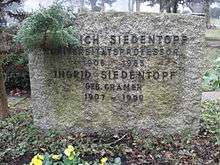Heinrich Siedentopf
Heinrich Friedrich Siedentopf (December 1, 1906 – November 28, 1963) was a German astronomer and physicist.
He was born in Hannover. In 1930, he became an assistant to Heinrich Vogt, then joined the national observatory in Heidelberg. Between 1940–46 he was a professor of astronomy at the University of Jena, and director of the observatory. In 1949, he was a professor at the University of Tübingen,[1] where he later died of a heart attack.
Professor Siedentopf published a total of 146 papers and a textbook. He studied cosmology, stellar convection,[2] photometry and the zodiacal light.[3] In 1934, he developed an adjustable iris for the Stetson-Schilt photometer, allowing the observer to adjust the light level directed at the astronomical plate.[4][5]

Siedentopf crater on the Moon[6] and the main belt asteroid 5375 Siedentopf were named after him.
References
- Barnstedt, Jürgen (September 29, 2005). "History and Chronicle of Astronomy in Tübingen". Institut für Astronomie und Astrophysik. Retrieved April 11, 2009.
- Zirker, Jack B. (2002). Journey from the Center of the Sun. Princeton University Press. p. 62. ISBN 0-691-05781-8.
- "Obituary: Heinrich Siedentopf". Irish Astronomical Journal. 9: 165. 1969. Bibcode:1969IrAJ....9..165.
- "History of Photometry in Astronomical Observations". McCormick Museum. December 28, 2005. Retrieved April 11, 2009.
- Hearnshaw, J. B. (1996). The measurement of starlight: two centuries of astronomical photometry. Cambridge University Press. p. 292. ISBN 0-521-40393-6.
- Blue, Jennifer (July 25, 2007). "Gazetteer of Planetary Nomenclature". USGS. Retrieved August 5, 2007.